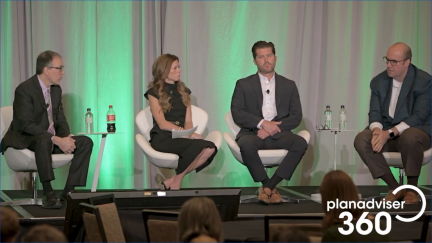Want the latest retirement plan adviser news and insights? Sign up for PLANADVISER newsletters.
The Role of Guaranteed Minimum Benefit Riders in In-Plan Annuities
With some riders, participants can enjoy the upside of the market with downside protection.
When it comes to annuity riders such as a guaranteed minimum withdrawal benefit (GMWB), or other types of riders being used for in-plan choices, there are two main approaches that are currently most popular in retirement plans, says Eric Henderson, president of Nationwide Annuity at Nationwide Financial.
“The first is a variable annuity with a guaranteed lifetime withdrawal benefit [GLWB] rider,” Henderson says. The GLWB allows the annuity owner to take regular or occasional withdrawals from the annuity during the accumulation period before it is annuitized. Henderson says this option is also very popular in the retail world. Should the market perform well, the annuitant can get that upside, and even if the account value went to zero, the annuitant would continue to get the guarantee, he notes. “It guarantees you to get some amount no matter how the market performs or how long you live,” Henderson says.
Plans are also offering deferred income annuities, which kick in at a later age, typically at a person’s life expectancy, Henderson says. “These are almost always a fixed product,” he says. “It does not give you participation in the market but it is fixed, no matter what,” and it protects the owner from longevity risk, he adds.
A few target-date funds (TDFs) have annuities with GLWB riders, Henderson says. These TDFs do not begin purchasing annuities until the owner reaches age 45 or 50. “By age 60, the TDF might have all of its assets in a variable annuity with a GLWB,” he says. “For the participant, this is all happening behind the scenes. They just see on their statement how much money they will receive each month for as long as they live.”
AllianceBernstein launched a TDF series in 2010, Secure Retirement Strategies, that has this type of annuity in it, and Nationwide is one of the three insurers in the glide path, Henderson notes. Barclays Global Investors, now BlackRock, pioneered the structure with its LifePath Retirement Income funds in 2007, and Prudential Financial also has TDFs with annuities.
Henderson says he expects that the Setting Every Community Up for Retirement Enhancement (SECURE) Act will prompt more TDF issuers to embrace annuities in their glide paths.
Bob Melia, executive director of the Institutional Retirement Income Council, says GMWB and GLWB riders are like guaranteed monthly income benefit (GMIB) riders. They just calculate the payout differently, Melia says. He says TDFs that have annuities with these types of riders might be beneficial to participants, but he is not in favor of sponsors that offer annuities outright in their plans attaching riders to them. When a person selects an annuity with a rider, it is to address their personal situation, Melia says. Sponsors cannot make these decisions wholesale for all the participants in their plans, he says.
“Those decisions belong in the financial planning world, not the defined contribution [DC] world,” he says. “The value propositions are slightly different in all of these types of annuities with riders. It is up to the individual to think through what they want. Financial planners can talk to their clients to get a risk profile and find out their financial goals.”
You Might Also Like:

Managed Accounts, TDFs or Both?

Three-Quarters of Annuity Owners Confident About Ability to Retire on Time
